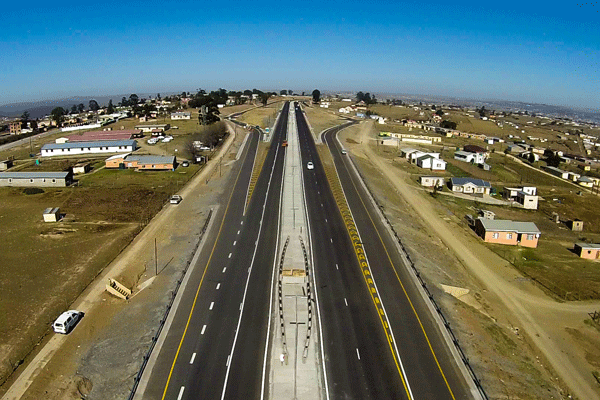
The South African National Roads Agency (SOC) Limited (SANRAL) has completed major work on the R61 mega-road infrastructure project in the Eastern Cape.
The R550-million Mthatha Sprigg Street to Ngqeleni Road infrastructure development and safety programme is also part of a master plan for tourism and other long-term mega projects in the Eastern Cape.
About the project
The project commenced on 16 September 2013 and was completed on 8 September 2017. The project consisted of the construction of a new 7.3km dual carriageway between Mthatha and the turn off to Ngqeleni. The east bound carriageway was newly constructed, while the west bound carriageway entailed an upgrade of existing road infrastructure.
As a result of the new carriageway, six new bridges – one each over the Mthatha River, the Corana River, Sidwadweni River on Bernard Schultz Drive, an agricultural overpass bridge at Ngqeleni turn-off, and two new interchange bridges at the Ngqeleni turn-off – were constructed.

Two large agricultural underpass culverts were also constructed.
Mbulelo Peterson, SANRAL Southern Region manager, said: “The R61 Mthatha Sprigg Street to Ngqeleni turn-off project is one of several projects, each with different starting and completion dates in a mega-road infrastructure development and safety programme for the R61 which commenced in 2011, and which will be completed by 2020.”
Road users at SANRAL’s heart
The plan is to improve the safety of the road users and pedestrians through the closing of unsafe intersections, a new interchange at Ngqeleni turn-off and the construction of formalised and channelised intersections.
This is also an integrated road safety programme which aims to decrease the road hazards, which may lead to accidents and motor vehicle accident related deaths.
Many accidents on the R61 between Mthatha and Ngqeleni involve motorists hitting stray animals. Between December 2014 and January 2015, local traffic authorities impounded 266 stray animals including goats, cattle, sheep and donkeys.
To address the problem, SANRAL has constructed two agricultural underpass culverts as part of the R61 Mthatha Sprigg Street to Ngqeleni turn-off project.
Community development
The project has created work for 60 small, medium and micro enterprises (SMMEs), of which 48 were black-owned entities. There were 628 job opportunities created, of which 541 (86%) were male and 87 (14%) female and further broken down into 328 youth (52%).
“One of the successes is that the project has already injected a salvo of benefits to members living in villages from Mthatha to Ngqeleni,” said Peterson.
SANRAL delivered 31 new replacement houses to residents whose dwellings fell under the construction footprint and in the process eradicated poorly constructed structure homes. “The project has also brought meaningful initiatives of social development to residents and communities,” said Peterson.
Training and skills development initiatives also benefitted members of the local communities. Sixteen Walter Sisulu University students from the community also gained on-site experiential training in order to obtain their diploma qualification.
Local SMMEs were mentored in the construction of houses according to National Home Builders Registration Council (NHBRC) standards. They also participated in several courses, which include construction tendering, basic computer literacy skills, site administration and monitoring. The workers have been provided with, among others, road safety and environmental awareness training.
The project also links with other programmes including the conversion of Sprigg Street and Madeira Street in Mthatha’s Central Business District (CBD) into one-way system to help improve traffic flow.
Challenges along the way
The risks of working on the project included work that was carried out in a heavily trafficked and densely populated built up area, and within a confined construction zone involving the simultaneous construction of earthworks, structures, and the relocation of services.
This, along with the interface between formal and traditional land tenure systems for land acquisition and relocation of communities have produced unique challenges, which SANRAL solved through proper planning and continuous stakeholder engagement.
The operation of heavy earth-moving equipment required and rock blasting in close proximity to residential and business dwellings also presented a special challenge.

